Envision Math Grade 8 Volume 1 Chapter 6 Congruence And Similarity
Page 303 Exercise 1 Answer
Given:
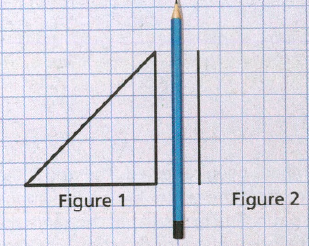
To: How are the figures the same? How are they different?
The pencil worked as a axis of reflection along which the figure one is reflected to make the figure two. When the pencil is removed and the paper is folded along the line, the two figures will overlap each other.
The pencil worked as a axis of reflection along which the figure one is reflected to make the figure two. When the pencil is removed and the paper is folded along the line, the two figures will overlap each other
Envision Math Grade 8 Volume 1 Chapter 6.3 Solutions
Page 303 Exercise 2 Answer
Given:

To find: What do you notice about the size, shape, and direction of the two figures?
As the figure 2 is the reflection of figure 1 the shape and size must be same. Also it can be observed that both the figures are right-handed triangles. But the location of their vertices are different in both the quadrants. Hence, directions are different.
As the figure 2 is the reflection of figure 1 the shape and size must be same. But the directions are different.

Page 303 Focus On Math Practices Answer
Given: Dale draws a line in place of his pencil and folds the grid paper along the line.
To: How do the triangles align when the grid paper is folded? Explain.
The line in place of pencil is acting like a axis of reflection. So the distance of both the figures from the line will be equal. So when the paper is folded, the vertical line of the figures will overlap. The base of the figure will overlap. Since both the figures have same size so the third side will also overlap.
The vertical line of the figures will overlap. The base of the figure will overlap. Since both the figures have same size so the third side will also overlap.
Page 304 Essential Question Answer
Given: Two-dimentional figure.
To: How does a reflection affect the properties of a two-dimensional figure?
When reflection takes place about x axis, the x coordinate remains the same, but the y coordinate is transformed into its opposite sign.
When reflection takes place about y axis, the y coordinate remains the same, but the x coordinate is transformed into its opposite sign.
When reflection takes place about x axis, the x coordinate remains the same, but the y coordinate is transformed into its opposite sign.
When reflection takes place about y axis, the y coordinate remains the same, but the x coordinate is transformed into its opposite sign.
Page 304 Try It Answer
Given:

To: Draw the new location of the chair on the plan.
Step formulation: Take the mirror image of the chair and then draw the final image.
Take the reflection of the chair about the dotted line and then draw the final image.
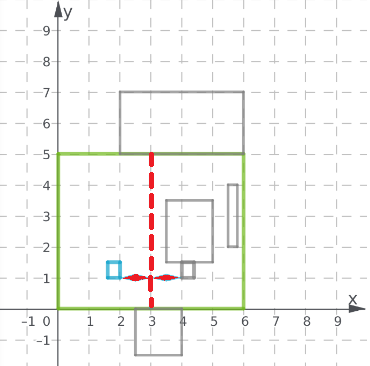
The final image of chair is shown in the figure:
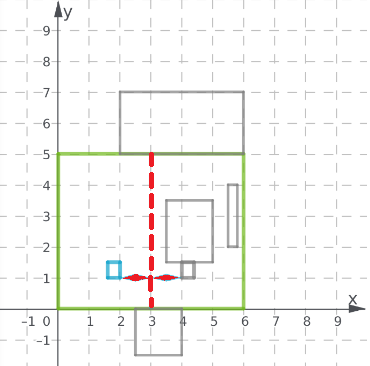
Page 304 Convince Me Answer
Given: Image is reflected.
To: How do the preimage and image compare after a reflection?
A reflection is a transformation that turns a figure into its mirror image by flipping it over a line. The line of reflection (or axis of reflection) is the line about which the figure is reflected over. If the reflecting point is on the line of reflection then the image is the same as the preimage. Also, the image is always congruent to its preimage i.e. have the same shape and size.
A reflection is a transformation that turns a figure into its mirror image by flipping it over a line. The line of reflection (or axis of reflection) is the line about which the figure is reflected over. If the reflecting point is on the line of reflection then the image is the same as the preimage. Also, the image is always congruent to its preimage i.e. have the same shape and size.
Page 305 Try It Answer
Given:
k = 2,6
L = 3,8
M = 5,4
N = 3,2
To find: The coordinates of point N′.
As the reflection is about the y axis, therefore, the y coordinate will remain the same and the x coordinate will change its sign.
i.e. N′= −3,2
The coordinates of N after reflection is −3,2.
Congruence And Similarity Envision Math Exercise 6.3 Answers
Envision Math Grade 8 Volume 1 Student Edition Solutions Chapter 6 Congruence And Similarity Exercise 6.2 Page 306 Exercise 4 Answer
Given:
A figure with two triangles.
To find:
Triangle X′Y′Z′ is a reflection of triangle XYZ.
From the picture we can see that vertices X and X′,Y and Y′,Z and Z′ are on the same distance from the line g,but on opposite sides.
Also, we can see that triangles have the same size and the same shape.
Therefore, triangle X′Y′Z′ is a reflection of triangle XYZ across the line g.
Triangle X′Y′Z′ is a reflection of triangle XYZ across the line g.
Page 306 Exercise 5 Answer
Given:
coordinate grid.
To find:
Describe the reflection of the figure EFGH.
We have to find the line of reflection over which a figure EFGH is reflected.
Notice that the line of reflection will be the line through the points that represent the half of lengths between the corresponding vertices.
In that case, we can say with certainty that each vertex of reflected figure will be on the same distance from the line of reflection.
Because the midpoint of the length divide length into two equal parts.
We first find the mid point of the length of vertices E and E′.

Let’s repeat the procedure for the corresponding vertices.
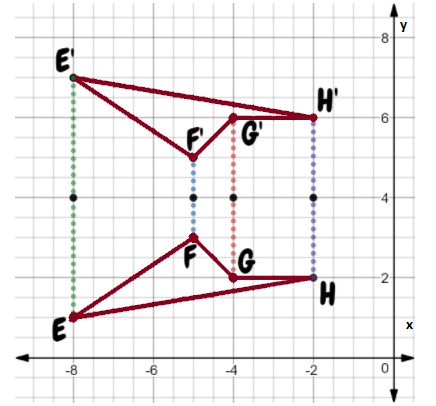
Now we draw all the points connecting the mid points to get the line of reflection.

Hence, EFG is reflected across y = 4.
Envision Math Grade 8 Chapter 6.3 Explained
Envision Math Grade 8 Volume 1 Student Edition Solutions Chapter 6 Congruence And Similarity Exercise 6.2 Page 307 Exercise 7 Answer
Given:
The graph of a trapezoid.
To find:
Reflection of trapezoid ABCD across the y-axis.
Use the law of reflection to find solution of the question.
Let’s
reflect each vertex of trapeziod ABCD across the y-axis.
Before each reflection, we have to measure distance from each vertex to line of reflection, y-axis.
For example, vertex A is 2 units right from the y-axis. Therefore, vertex A′ must be 2 units left
from the line y-axis.
Then we repeat the procedure for other vertices,
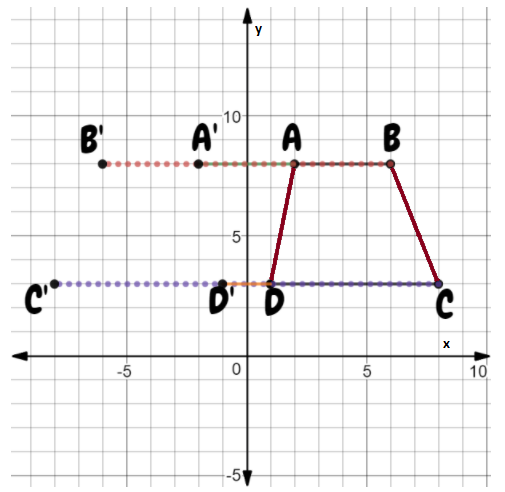
Then joining the points we get,
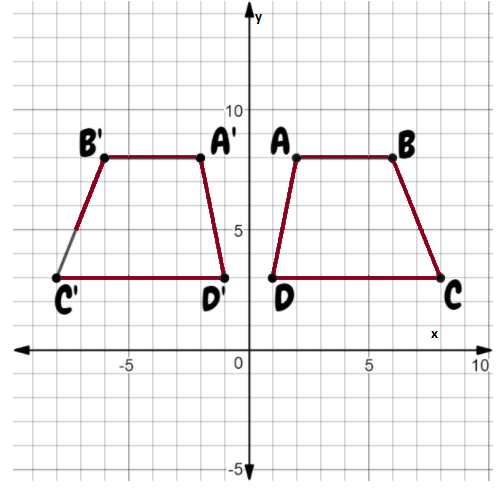
Let’s identify first the points of the preimage:
A(2,8) B(6,8) C(8,3) D(2,3)
When we reflecting across the y-axis only x-values are opposite.
The y−values stay the same when we reflect a preimage the y-axis.
Because, during reflection across the y-axis and lines that are parallel with y-axis, we move only along the x-axis
Reflection acrossy−axis:(x,y)→(−x,y)
So, the points of the image:
A′(−2,8) B′(−6,8) C′(−8,3) D′(−2,3)
Plotted trapezoid is
A′(−2,8) B′(−6,8) C′(−8,3) D′(−2,3)
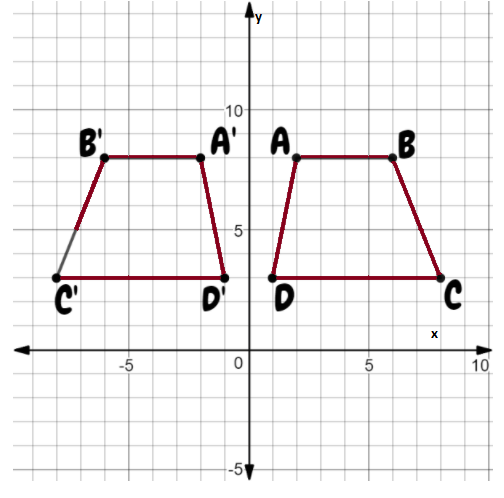
Page 307 Exercise 8 Answer
Given:
A figure with two triangles A′B′C′ and ABC
To find:
A′B′C′ and ABC are reflection across the line.
A reflection is a transformation that flips a figure across a line of reflection.
The preimage and image are the same distance from the line of reflection but on opposite sides So, figures have the same size and the same shape but different orientation after reflection.
If we look at the picture, we can see that corresponding vertices of triangles are not on the same distance from the line of reflection and that triangles are not opposite.
Therefore, the triangle A’B’C’ is not a reflection of triangle ABC.
The triangle A′B′C′ is not a reflection of triangle ABC.
Page 308 Exercise 11 Answer
Given:
Vertices of triangle ΔABC are A(−5,5),B(−2,3);C(−2,3)
To find:
The coordinate C′ when the triangle is reflected across y = −1.
When we reflect triangle ABC across the line y = −1,that means we are reflecting each vertex on the same distance from the line of reflection y = −1 on opposite side.
To find the coordinates of the vertex C′, first we have to measure the length between the vertex C and the line y = −1. Because, on the same distance from the line of reflection must be the corresponding vertex C′.
Notice that, when we reflect the figure across some line that is parallel to the x-axis
like y=−1,the x-values of all points of the figure will be the same
Because, we reflect the figure along y-axis. The y-values will changed.
If coordinates of vertex C are (−2,3) that implies that vertex C is 3 units up from y-axis. But we have to find the number of units to the line y = −1. So, we are looking for value of r that is true for equation:
3 − (−1) = r
r = 4
(Notice that when we move downwards. we subtract the values.)
The vertex C is 4 units up from the line of reflection. Therefore, the vertex C′ must be 4 units down from the line of reflection.
In another words, the second coordinate of point C′ will be:
−1 − 4 = −5
So, the coordinates of the vertex C′ are :(−2,−5).
The coordinates of the vertex C′ are :(−2,−5).
Solutions For Envision Math Grade 8 Exercise 6.3
Envision Math Grade 8 Volume 1 Student Edition Solutions Chapter 6 Congruence And Similarity Exercise 6.2 Page 308 Exercise 12 Answer
Given:
A figure with two parallelogram.
To find:
What reflection of ABCD is A′B′C′D′.
To describe the reflection of a parallelogram ABCD, we have to find the line of reflection over which a parallelogram ABCD is reflected.
Notice that the line of reflection will be the
Line through the points that represent the half of lengths between the corresponding vertices.
In that case, we can say with certainty that each vertex of reflected figure will be on the same distance from the line of reflection.
Because the midpoint of the length divide length into two equal parts.
We find the midpoint of the length of vertices A and A′:
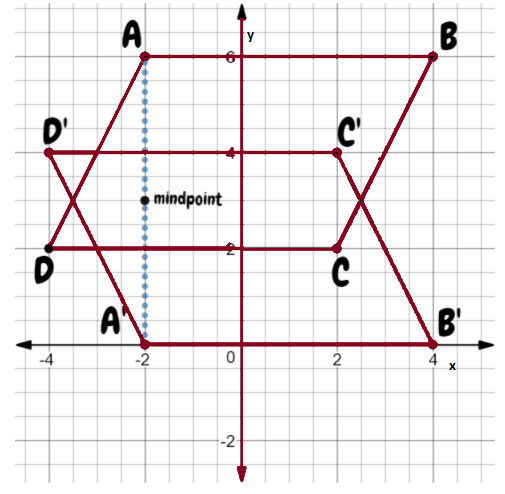
We repeat the process for rest of the vertices and then join the points to get the line of reflection.
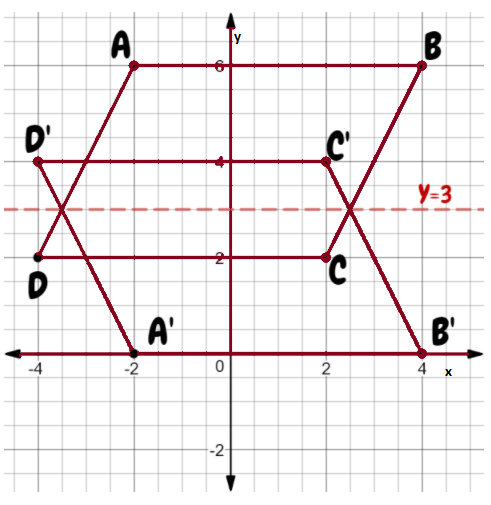
Therefore, ABCD is reflected across the line y = 3.
Envision Math Grade 8 Volume 1 Chapter 6.3 Practice Problems
Page 308 Exercise 13 Answer
Given:
ΔJAR has vertices J(4,5);A(6,4);R(5,2)
To find:
Correct graph for ΔJAR across x = 1.
First notice that image of triangle at is not only reflected but also translate some units up from the original one. Therefore, the are not the same distance between the line of reflection and corresponding vertices.
Then, on the image C vertices are not reflect to the corresponding ones. Moreover, these two angles have not the same corresponding side lengths and angle measures.
Now we have two options: A or B.
Let’s look first at the image A. As we already said, reflected figures are the same distance from the line of reflection but on opposite sides.
If we look the number of units between vertex A and line, then between line and vertex A′, we can notice that these are not the same numbers. In another words, the vertices are not on the same distance from the line of reflection.
Let’s look first at the image B. As we already said, reflected figures are the same distance from the line of reflection but on opposite sides.
If we look the number of units between vertex B and line, then between line and vertex B′, we can notice that these are the same numbers. In another words, the vertices are on the same distance from the line of reflection. Hence B is the correct option.
Graph B is correct.
Given:
∠A = 90
To find:
m ∠ A
We use the corresponding angle measures remain the same by reflection.
The corresponding angle measures remain the same by reflection.
Therefore, true is:
m ∠ A = 90∘ ⇒ m ∠ A′ = 90∘
Therefore,
m ∠ A′ = 90∘
